Random Noise 24
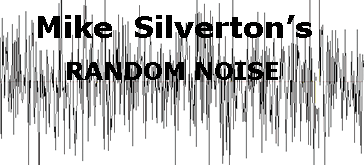
Random Noise 24
Acoustic Revive’s Special Edition Single Core Interconnects
Single Core, singleness of purpose
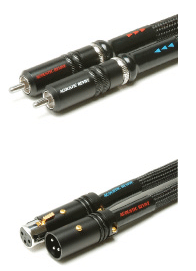 According to Yoshi Hontani, my affable and invaluable English-speaking contact, a recent change to Acoustic Revive’s top-of-the-line, assembled-on-demand audio cables puts them at the top of the heap. (I do so admire enthusiasm!) As an audio journalist who’s written about, and uses, Ken Ishiguro’s remarkable products, I’ve been asked to spread the Word among my Anglophone brethren and sistren. Yoshi-san is particularly eager for me to include in my remarks AR’s top RCA interconnect, the Special Edition Single Core (henceforward SESC). The SESC’s balanced (XLR) interconnect has been available long enough to have shed its new-product aura. The SESC RCA is the more recent addition.
According to Yoshi Hontani, my affable and invaluable English-speaking contact, a recent change to Acoustic Revive’s top-of-the-line, assembled-on-demand audio cables puts them at the top of the heap. (I do so admire enthusiasm!) As an audio journalist who’s written about, and uses, Ken Ishiguro’s remarkable products, I’ve been asked to spread the Word among my Anglophone brethren and sistren. Yoshi-san is particularly eager for me to include in my remarks AR’s top RCA interconnect, the Special Edition Single Core (henceforward SESC). The SESC’s balanced (XLR) interconnect has been available long enough to have shed its new-product aura. The SESC RCA is the more recent addition.
Truth be told, among audiophiles here in the US, precious few know much, if anything, about Acoustic Revive cables. I’m here, as I say, to shed some light. However, a thoroughgoing cable report – involving, perhaps, a dozen or so comparisons – is a pleasure on the order of a black-site rendition. So here’s what your sincere albeit lazy reporter proposes:

The Integris CDP has returned from its Canadian sojourn (AurumAcoustics.com – well worth a look). I’ll be using it for my remarks since it requires but one set of cables, balanced or single-ended: CDP to amps. Before the Integris’s departure, I’d been using SESC XLRs. The NuForce CDP-8 and P-9 preamp that filled in for the Integris require two sets of interconnects: player to preamp, single-ended only; preamp to amps, single-ended or balanced. (The Integris’s “P” indicates a CD player with a full range of preamp functions. Elsewhere, the “P,” for immediate example, NuForce’s CDP-8, stands for player alone: preamp required.) I matured the SESC RCA pair as described above: from CDP-8 to P-9.
Taking on a champion
For the comparisons ahead, I’ll be using a pair of balanced interconnects widely regarded as among the breed’s best: Nordost Valhalla. A few other makes on the premises are nowhere near the Valhalla’s level of quality – or price: $4330 for a one-meter, XLR pair. To date, the Valhallas have outshone everything to which I’ve compared them. This will be a comparison between an XLR interconnect that’s earned its reputation and XLR and RCA interconnects the reputations of which are yet to be made, or largely so. While nowhere near Valhalla’s ticket, The SESC RCA and XLR interconnects nevertheless incline toward the scale’s high end. For a one-meter SESC XLR PAIR, $1995. For the one-meter SESC RCA pair, $1675.
Acoustic Revive’s Single Core designation refers to PCOCC-A: mono-crystal copper manufactured by the Ohno Continuous Casting method, to which Furukawa Electric holds the patent. The “A” suffix identifies an annealed version of this costly conductor. The PCOCC process, developed by Atsumi Ohno, dates from 1985. I’m told that a few cable manufacturers use PCOCC-A. I’m also told that the oval configuration is unique to Acoustic Revive. As mentioned, AR makes its top cables to order. The SESC interconnects’ polyolefin-coated conductors are identical to that used in the SPC-PA speaker cable: an atypically hefty 1.8mm x 1.4mm – atypical, that is, for an interconnect. Among other concerns, a great many Acoustic Revive innovations, oval conductors included, reflect Ken Ishiguro’s interest in vibration suppression can be seen here: for photographs of materials, applications, and sources, with accompanying texts. You can check out AR’s full product line atwww.acoustic-revive.com.
When I reinstated the Integris CDP and had no immediate use for the SESC RCA pair, I took a moment to look at the plug. Under the connector’s threaded shell, designed to clamp securely to its female counterpart, tiny golden set screws (gold-plated brass?) secure the conductors to a sturdy metal framework. The SPC-PA speaker cables’ conductors are similarly secured to their spade lugs, as are, I’m told, the SESC XLR’s conductors to their terminations. AR contends that solder degrades the signal. (I haven’t the courage to dismantle the SESC’s elegant XLR connector.) The company’s Web site also informs us that a “meister” assembles these cables by hand. Of particular interest are the woven silk inner sleeve, Teflon-coated, spiral copper tubing, and carbon-fiber outer sleeve. In terms of materials and their application, “unique” puts it nicely, as does “elegant.”
Audiophile earmuffs
An audio system’s sound first needs to penetrate the listener’s prejudices, tastes and predispositions. Someone who attends dozens of classical concerts and recitals yearly and accumulates recordings that, in his or her opinion, successfully mimic live, unamplified sonics is likely to be listening for qualities of little interest to heavy-metalurgists or hardcore punkeroos. Before and since the Integris CDP’s return, I’d been using the SESC XLRs while harboring fond memories of the Valhalla’s stellar sound. When it came to a comparison, I heard what I anticipated.
The Valhalla interconnect’s superb reputation rests on transparency, resolution, dynamic finesse and all-around truthfulness. The SESC pair sounded less airy. The Valhalla was the better resolver –– better, I thought, in every respect. I’ve since discovered why these comparisons favored the Valhalla. I shared my suspicion with Yoshi-san. We agree: owing to their conductors’ atypical size, the Special Edition interconnects require a longer maturation period than would a pair of jacks employing thinner conductors. I hadn’t run in the SESCs nearly long enough. (I used Acoustic Revive’s lighter-weight interconnects for my Sasha W/P review. They differ only with respect to the conductors’ size.)
Well and good, but is one’s patience rewarded?
Yes. Absolutely. The difference is one of emphasis. To a small but significant degree, the Valhalla and SESC’s sonic signatures differ. The SESC’s sound is rock-solid muscular, yet delicate where need be. Balanced or single-ended, the SESC flourishes with respect to transparency, resolution, spatiality and dynamic finesse. The “air” is there, albeit in a more midrange-centered, well-dimensioned presentation. As a personal matter –– and nothing’s more personal than a sound geek’s preferences –– I hear Acoustic Revive cables, power cords and power distribution boxes included, falling in line with Ken Ishiguro’s precepts about good sound and how to achieve it (not on the cheap, alas) –– precepts with which I am bound to agree. My ears have seen to that.
Can I hear a difference between the SESC XLR and RCA interconnects? Taking into account the need to raise the volume with the single-ended pair in use, none. Depending on the hardware, the disparity between balanced and single-ended can be as much as 6dB, which is the difference I think I’m hearing. With levels more or less matched, the XLR and RCA interconnects sound alike, as they should. If differences there be, they’re too subtle for me to detect. Given my druthers, I go with balanced. I prefer the hardware and, with this system, the additional gain. Hum is not a factor, nor should it be in any system with typically short cable lengths. (As I understand it, before it became a popular audiophile item, balanced cabling has long been used in professional settings where long runs can encounter hum.)
A few musical examples
To live with Acoustic Revive’s SESC interconnects is to love them – a soaring generality that needs a little meat on its wings.
 I was listening for the fourth or fifth time to NuScope’s most recent release,Under the Roof (NuScope CD 1023), with the British reed player, John Butcher, on tenor and soprano sax; and the Swiss pianist, Claudia Ulla Binder. I hear more good stuff with each replay. But I have a problem. I find that covering music is tough work that gets tougher. I mention this hangup only because a deus ex machina intervened.
I was listening for the fourth or fifth time to NuScope’s most recent release,Under the Roof (NuScope CD 1023), with the British reed player, John Butcher, on tenor and soprano sax; and the Swiss pianist, Claudia Ulla Binder. I hear more good stuff with each replay. But I have a problem. I find that covering music is tough work that gets tougher. I mention this hangup only because a deus ex machina intervened.
As I was listening, I flipped through the April, 2010 issue of Modern Painters and glanced at an attractive full-page ad on the back cover that delivered my aha!moment. Ace Galley mounted a Sam Frances show in their Beverly Hills space in 2007. A gorgeous photo of the installation shows a large, mostly white abstraction on the back wall flanked by almost entirely white abstractions on the side walls.
I know that a visual artist is better than merely good if his or her abstractions grab me by the innards, however disjunct, disparate, inchoate, or inharmonious the art’s constituent parts. The great ones cohere and communicate in one way or another. And of course the late Sam Francis is a whole lot better than merely good. He’s one of the twentieth century’s heavy hitters.
Under the Roof is the sounding equivalent of a superb visual abstraction. It coheres as it enlightens. Hovering somewhere between music and noise, its novel turns, incongruities and what-the-hell-was-that moments – the whole ball of sparkling wax – leave an indelible and perhaps challenging impression. To listen profitably, I suggest trying to create a mental passageway from the visual abstractions the music suggests to the music on its own, entirely sonic terms. Few such improvisational sessions I’ve heard facilitate the shift quite as well as this.
I’ve mentioned the solidity that AR’s SESC interconnects, XLR and RCA, bring to the recorded event. I cannot say with assurance that a less lifelike, with-me-in-the-room presentation would have made so deep an impression. I will say that when performance and engineering mesh at this level, amazing things happen, particularly through a playback system that throws open the doors to perception.
Remember bass and treble controls? Back in the Pleistocene, when I first took an interest in hi-fi, well endowed electronics included a presence control the questionable usefulness of which still clings to the term. When cabling heightens a recording’s presence, perhaps less controversially put as in-the-room occupancy, canned events spring to something like life. When this happens – none too often, I have to confess – the fuss and trouble we go to encounters its justification.
And then there’s Frank Zappa’s memorable quip, “Jazz isn’t dead, it just smells funny.” The instrumentalists I most admire more or less agree. The kind of music I’m drawn to these days isn’t jazz in any obvious, clearly identifiable sense, nor are its roots in the twentieth century’s avant-garde classical, though it does share a taste for the then vanguard’s interest in extended instrumental technique, strange combinations and yet stranger discourse – something you rarely hear in mainstream jazz of any era.
It’s a question of demeanor. Relative to vanguard classical, jazz-related events, however distant the relationship, strike a looser, more relaxed posture, or relatively so. The improvisation and noise-music I’ve been listening to falls closer to jazz than not. By contrast, avant-garde classical shares classical’s formality, be the music of the moment solemn, flippant, or straight-ahead madcap. For me the difference matters. As great a fan as I am of old and recent classical, the looser, catch-as-catch-can world of jazz-distant improvisational music, both true and faux, provides satisfactions at least as lasting.
I’ve been playing two Intakt CDs often enough to qualify the experience as a love affair. Pianist Sylvie Courvoisier and her husband, violinist Mark Feldman, blend playfulness, semi-serious sentiment, occasional dips into heart-rending sentimentality, and edge-dwelling (and, not insignificantly, audiophile-grade) noise into musical projectiles that score bull’s-eyes.
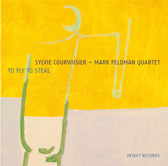 Feldman and Courvoisier are consummate musicians. Were they not, the chances and flights of fancy they take would not succeed as well as they do. Sylvie Courvoisier / Lonelyville, released in 2007 (Intakt CD 120), includes Feldman, along with Vincent Courtois, cello; Ikue Mori, electronics; and Gerald Cleaver, drums. The group participating in To Fly to Steal, released in 2010 (Intakt 168), identified as the Sylvie Courvoisier-Mark Feldman Quartet, includes Thomas Morgan, bass; and Gerry Hemingway, drums.
Feldman and Courvoisier are consummate musicians. Were they not, the chances and flights of fancy they take would not succeed as well as they do. Sylvie Courvoisier / Lonelyville, released in 2007 (Intakt CD 120), includes Feldman, along with Vincent Courtois, cello; Ikue Mori, electronics; and Gerald Cleaver, drums. The group participating in To Fly to Steal, released in 2010 (Intakt 168), identified as the Sylvie Courvoisier-Mark Feldman Quartet, includes Thomas Morgan, bass; and Gerry Hemingway, drums.
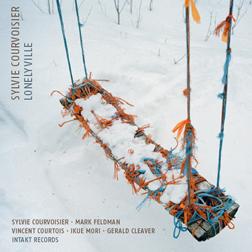 The word that comes to mind is cosmic. The sometimes abrupt transitions from virtuosic sentiment to swatches of pure abstraction give these releases their distinctive stamp. With respect to scope, perhaps owing to Ikue Mori’s subtle electronic contributions, Lonelyville takes the edge in the where-in-outer-space-are-we-headed department. One’s listener’s opinion, of course. You’d profit from arriving at your own opinions of either or both CDs. Impeccably recorded, chops aplenty. Two solid winners (I’ll be listening to again after I submit this column). For information, www.intaktrec.ch.
The word that comes to mind is cosmic. The sometimes abrupt transitions from virtuosic sentiment to swatches of pure abstraction give these releases their distinctive stamp. With respect to scope, perhaps owing to Ikue Mori’s subtle electronic contributions, Lonelyville takes the edge in the where-in-outer-space-are-we-headed department. One’s listener’s opinion, of course. You’d profit from arriving at your own opinions of either or both CDs. Impeccably recorded, chops aplenty. Two solid winners (I’ll be listening to again after I submit this column). For information, www.intaktrec.ch.
The last gasp
In all honesty, I made fewer Valhalla-SESC comparisons than I intended to. I was simply having too good a time with Acoustic Revive’s SESC interconnects. But Dame Duty called. The Emerson String Quartet recorded seven of Franz Josef Haydn’s string quartets in the Lefrak Concert Hall of Queens College, NYC, in 2000 and 2001, Da-Hong Seetoo, producer and recording engineer (Deutsche Grammophon 289 471 327-2, released in 2001). Seetoo, along with Max Wilcox, recorded the Emersons’ complete Shostakovitch quartets in Aspen in 1994, ’98 and ’99, Deutsche Grammophon 463 284-2, released as a thoroughly rewarding five-disc set in 2000).
In the two-disc Haydn set, the violins sound a tad bright – nothing objectionable, just the merest bit. I wondered whether the Valhallas would provide the necessary sweetness. Not. In fact, the tizziness grew a half-degree more irritating. The SESC’s way with lifelike presence proved the more satisfying. The SESC, RCA or XLR, gratify utterly.
***
Harumpf!
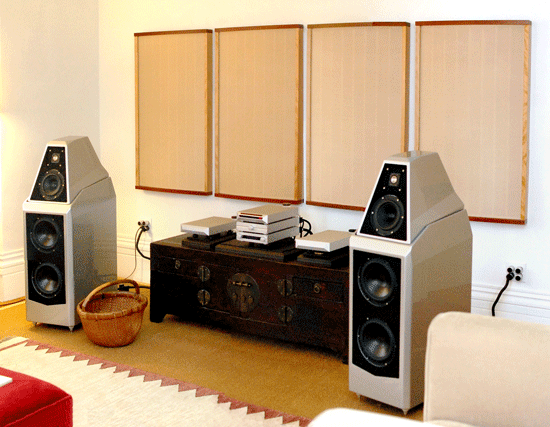
In Random Noise 23 I mentioned that I’d have more to say about a remarkable speaker. I can be brief. The Sasha W/P is a remarkable speaker. A lot of high-end audio gear is weirdly expensive. This is an expensive speaker system, yes, but the quality is there.
In that column I mentioned arriving at my impressions via NuForce electronics: CDP-8 player, P-9 preamp, and Reference 9SEV3 mono amps. In an outburst of naïve enthusiasm, I emailed the installation photos to friends and acquaintances, including one of our avocation’s senior poohbahs. He responded with scorn. I paraphrase: My tastes remain true to form. When, he asks, will I acquire gear that sounds like music? Wilson? NuForce? Hi-fi rubbish! (You can almost hear the snort of derision.)
These haughty bitch-slaps give audiophilia its singular flavor. You don’t see stamp collectors carrying on like this. The analogy is not inappropriate. An audiophile may well question the sanity of a philatelist who drops a bundle on a patch of paper, just as the philatelist wonders at the audiophile’s willingness to drop a similaly fat wad on a fancy-dancy jack.
But already I see daylight through chinks in the comparison. Quite a few of those paper patches will increase in value. Fancy-dancy jacks, not. On the other hand, patches of philatelic paper all sound alike. (And probably taste alike.) Licking aside, the same cannot be said for fancy-dancy jacks –– at least in the opinion of subjectivists like me. And we’ve yet to take into account the double-blind crowd. And the beat goes on…
Harumpf! 
![]()
Don’t forget to bookmark us! (CTRL-SHFT-D)
Stereo Times Masthead
Publisher/Founder
Clement Perry
Editor
Dave Thomas
Senior Editors
Frank Alles, Mike Girardi, Key Kim, Russell Lichter, Terry London, Moreno Mitchell, Paul Szabady, Bill Wells, Mike Wright, Stephen Yan, and Rob Dockery
Current Contributors
David Abramson, Tim Barrall, Dave Allison, Ron Cook, Lewis Dardick, Dan Secula, Don Shaulis, Greg Simmons, Eric Teh, Greg Voth, Richard Willie, Ed Van Winkle, and Rob Dockery
Music Reviewers:
Carlos Sanchez, John Jonczyk, John Sprung and Russell Lichter
Site Management Clement Perry
Ad Designer: Martin Perry





Be the first to comment on: Random Noise 24